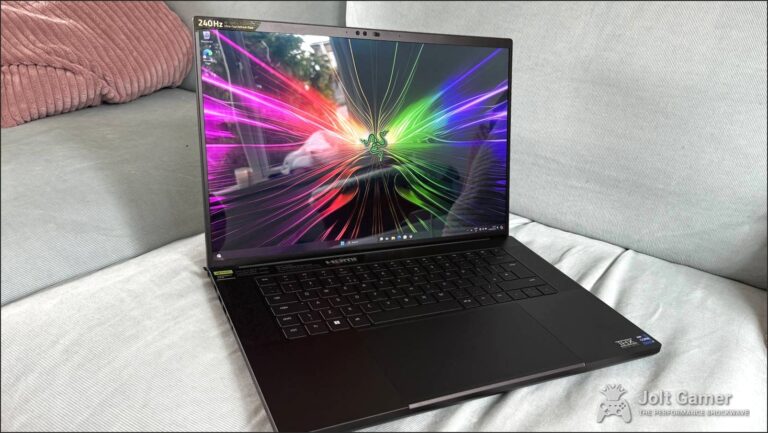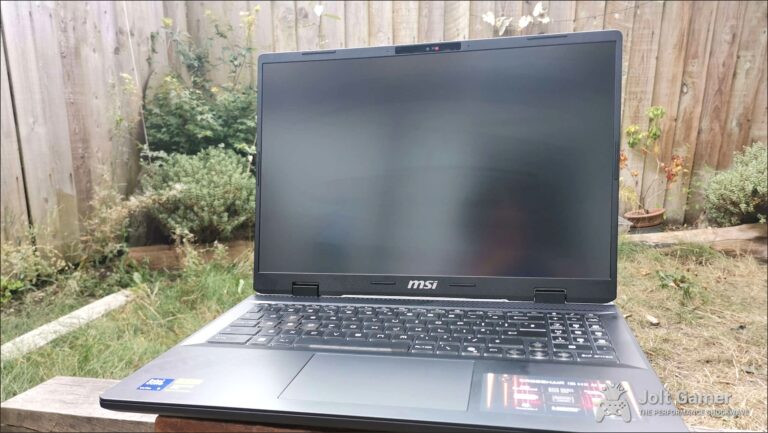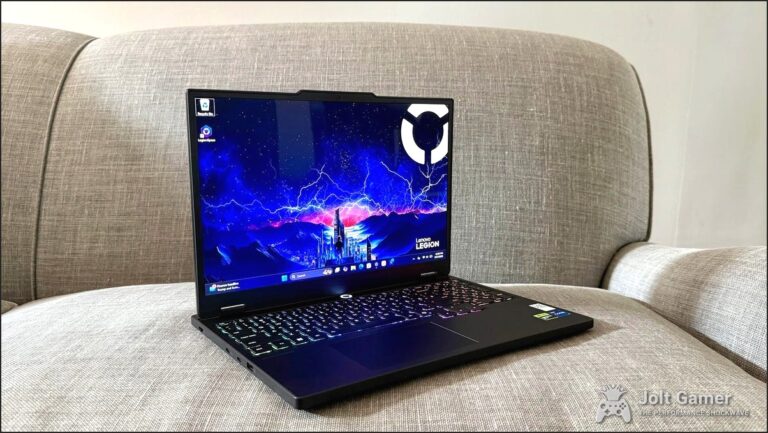Key Takeaways: Acer Predator Helios Neo AI (2025)
Pros
- Powerful Next-Gen AI Hardware: Features Intel Core Ultra 200HX and NVIDIA RTX 50 Series GPUs with DLSS 4 for cutting-edge gaming performance.
- Stunning Display Options: Offers OLED (16-inch) and Mini LED (18-inch) WQXGA panels with high refresh rates (240-250Hz) and G-SYNC.
- Competitive Pricing: Positioned as an affordable entry into high-performance AI gaming, offering strong value for initial purchase.
- Advanced Cooling Solutions: Incorporates 5th Gen AeroBlade 3D fans, liquid metal, and vector heat pipes for thermal management.
Cons
- Significant Long-Term Reliability Concerns: Community reports highlight issues with VRAM limitations for 3D development, liquid metal spills, and screen hinge durability.
- Persistent Overheating & Fan Noise: Users report severe thermal throttling and excessively loud fans, even with low CPU usage, raising questions about sustained performance.
- Subpar Peripherals & Battery Life: Criticisms include a small, unresponsive trackpad, poor speaker quality, and notably short battery life, limiting portability.
- Hidden Costs & Maintenance Risks: Potential design flaws may lead to costly repairs, impacting the overall value proposition despite initial affordability.
Overall Summary
The Acer Predator Helios Neo AI (2025) delivers impressive next-gen performance and display quality at a competitive price, making it an attractive option for gamers. However, significant community concerns regarding long-term durability, VRAM limitations for advanced tasks, persistent overheating, and design flaws warrant caution. Buyers should weigh the cutting-edge power against potential reliability issues and hidden maintenance costs.
The AI Gaming Revolution: Introducing the Acer Predator Helios Neo AI (2025)
Acer officially unveiled its expanded Predator Helios Neo portfolio on February 7, 2025, in Katowice, Poland, introducing the all-new 16-inch Predator Helios Neo 16 AI (PHN16-73) and the 18-inch Predator Helios Neo 18 AI (PHN18-72) gaming laptops. These devices are strategically positioned to offer competitive price points while integrating next-generation AI-powered hardware. With a subdued minimalist design, accented by an RGB logo on the lid and dynamic 4-zone RGB keyboards, Acer signals a deliberate focus on core components to maximize value without compromising on the latest technological advancements. This approach aims to deliver a potent blend of high performance and aesthetic appeal for both gamers and demanding professionals.
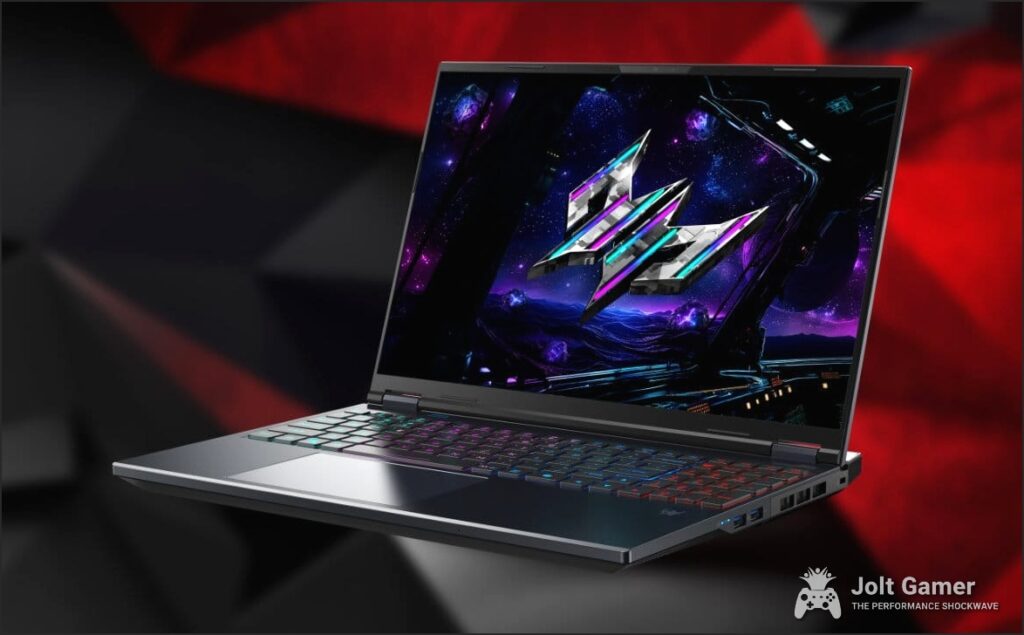
Powering the Future: Intel Core Ultra 200HX & NVIDIA RTX 50 Series
At the core of the new Predator Helios Neo AI laptops lies a formidable blend of next-generation processing and graphics power. Users can configure these machines with up to an Intel Core Ultra 9 275HX processor from the new Intel Core Ultra 200HX Series, engineered for ultra-smooth, responsive gameplay. Graphics are driven by NVIDIA GeForce RTX 50 Series Laptop GPUs, configurable up to an NVIDIA GeForce RTX 5070 Ti, leveraging the cutting-edge NVIDIA Blackwell architecture. These GPUs are not just about raw power; they boast significant AI horsepower with 4th gen RT Cores and 5th gen Tensor cores. This enables critical features like NVIDIA DLSS 4, a neural rendering suite that uses AI to significantly boost FPS, reduce latency, and enhance overall image quality. Further optimizing the experience, Intel Application Optimization fine-tunes game and system performance. Both models support up to 64 GB of 6400 Hz DDR5 system memory and up to 2 TB of PCIe Gen 4 SSD storage across two slots, providing ample capacity and blistering speed for even the most demanding games and creative applications.
Acer Predator Helios Neo AI (2025) Key Specifications
| Predator Helios Neo 16 AI (PHN16-73) | Predator Helios Neo 18 AI (PHN18-72) | |
|---|---|---|
| Model | Predator Helios Neo 16 AI (PHN16-73) | Predator Helios Neo 18 AI (PHN18-72) |
| Processor (Max) | Intel Core Ultra 9 275HX | Intel Core Ultra 9 275HX |
| GPU (Max) | NVIDIA GeForce RTX 5070 Ti Laptop GPU | NVIDIA GeForce RTX 5070 Ti Laptop GPU |
| RAM (Max) | 64 GB DDR5 6400 MHz | 64 GB DDR5 6400 MHz |
| Storage (Max) | 2 TB PCIe Gen 4 SSD (2 slots) | 2 TB PCIe Gen 4 SSD (2 slots) |
| Display (16-inch) | OLED WQXGA (2560×1600) 240 Hz, 1ms, 100% DCI-P3 | N/A |
| Display (18-inch) | N/A | Mini LED WQXGA (2560×1600) 250 Hz, 3ms, 100% DCI-P3 |
| Display Features | NVIDIA G-SYNC, Advanced Optimus, MUX Switch | NVIDIA G-SYNC, Advanced Optimus, MUX Switch |
| Cooling | 5th Gen AeroBlade 3D fans, liquid metal, Vector Heat Pipes | 5th Gen AeroBlade 3D fans, liquid metal, Vector Heat Pipes |
| Connectivity | Intel Killer Ethernet E3100G, Wi-Fi 6E (1675i), Thunderbolt 4 | Intel Killer Ethernet E3100G, Wi-Fi 6E (1675i), Bluetooth 5.4+, Thunderbolt 4 |
| Battery | 90 Whr | 90 Whr |
| Weight | 2.7 kg | 3.3 kg |
| OS | Windows 11 Home + 3-month PC Game Pass | Windows 11 Home + 3-month PC Game Pass |
| Starting Price (NA) | USD 1,899.99 (April 2025) | USD 2,199.99 (May 2025) |
| Starting Price (EMEA) | EUR 1,699 (May 2025) | EUR 1,799 (June 2025) |
Immersive Visuals & Advanced Cooling
Beyond sheer processing power, the Predator Helios Neo AI series is meticulously engineered to deliver an immersive visual experience. The 16-inch model features an OLED WQXGA (2560×1600) panel, boasting a blazing 240 Hz refresh rate and a rapid 1 ms response time, which translates to incredibly vibrant colors, deep blacks, and fluid motion. For those requiring a larger display, the 18-inch variant offers a Mini LED WQXGA (2560×1600) panel with an even higher 250 Hz refresh rate and a 3 ms response time. Both displays are further enhanced with NVIDIA G-SYNC technology, NVIDIA Advanced Optimus, and a MUX Switch, collectively ensuring fluid, tear-free visuals and optimized graphics performance by intelligently managing GPU output. To prevent thermal throttling and maintain peak performance during extended, intense gaming sessions, Acer has integrated a sophisticated cooling system. This includes Acer’s 5th Gen AeroBlade™ 3D fans, a crucial component for efficient airflow, complemented by liquid metal thermal grease applied to the CPU, and an array of Vector Heat Pipes. These elements work in concert to dissipate heat effectively, aiming to sustain high clock speeds under load.
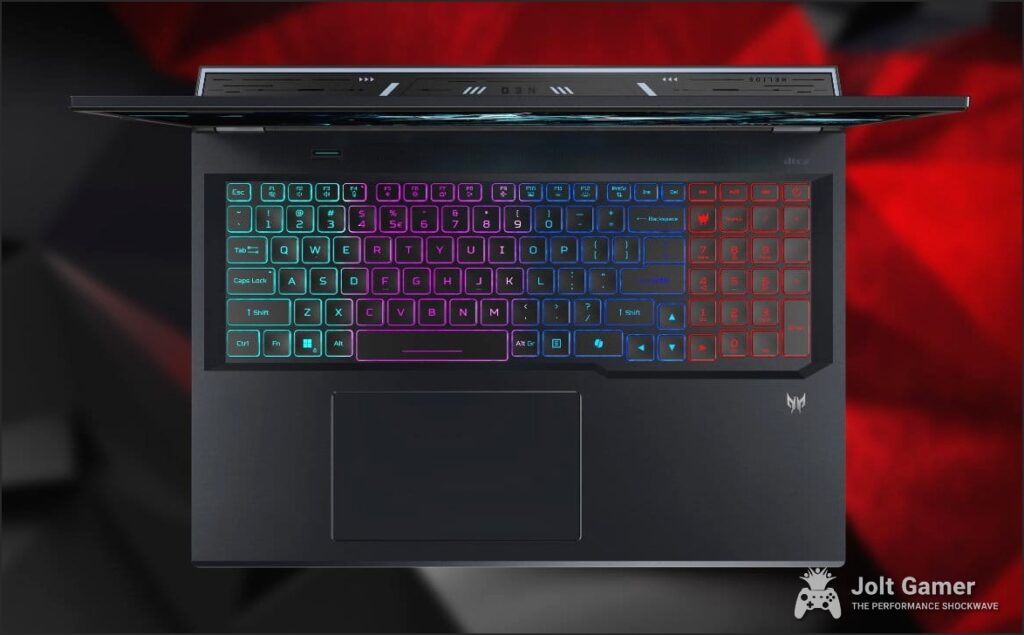
Real-World Performance & The AI Advantage
With the formidable integration of Intel Core Ultra 200HX processors and NVIDIA GeForce RTX 50 Series GPUs, the Predator Helios Neo AI laptops are unequivocally poised to deliver exceptional gaming performance. The NVIDIA Blackwell architecture, coupled with the advanced capabilities of DLSS 4, promises significant FPS boosts and enhanced visual fidelity, making even the most demanding titles playable at high resolutions and refresh rates. While concrete benchmarks for the RTX 50 series are not yet publicly available, we can confidently anticipate a notable generational leap over the RTX 40 series. For empirical context, the previous 2024 Helios Neo 16, equipped with an RTX 4070, consistently surpassed 60fps in most contemporary games and achieved over 100fps in titles like Starfield at 1080p. The new AI-powered hardware is expected to push these boundaries further, offering smoother gameplay and more immersive experiences, particularly with ray tracing enabled. The inclusion of a three-month PC Game Pass subscription also ensures immediate access to a robust library of titles, allowing users to rigorously test the capabilities of their new machine from day one.
Simulated Gaming Performance: Predator Helios Neo 16 AI (RTX 5070 Ti) vs. RTX 4070
Simulated data based on expected generational improvements and DLSS 4. Actual performance may vary.
The Community Pulse: Hype, Anxiety, and Unforeseen Challenges
While Acer’s official announcements paint a compelling picture of unbridled power and innovation, a closer examination of real-world experiences and anxieties within the PC gaming community offers a more nuanced, and often contradictory, perspective. The “Fandom Pulse” reveals a significant emotional conflict: initial enthusiasm for raw performance is frequently tempered by deep-seated concerns regarding long-term reliability, specific hardware limitations, and potential unforeseen costs. This dichotomy is not merely anecdotal; it represents a critical consideration for any prospective buyer, demanding a balance between advertised specifications and lived user experience.
Community-Driven Pros & Cons of the Predator Helios Neo Series
Pros
- Strong Gaming Performance: Initial reports and expectations for the RTX 50 series suggest excellent FPS and smooth gameplay across demanding titles.
- High-Quality Displays: Users consistently praise the vibrant colors, high refresh rates, and crisp resolutions of Predator displays (OLED/Mini LED).
- Tactile Keyboard Experience: The keyboard is frequently highlighted as one of the best, offering a satisfying typing and gaming feel with great RGB.
- Initial Value Proposition: Many perceive the laptop as a good value at purchase, especially for its powerful components at a competitive price point.
Cons
- VRAM Limitations for Advanced Use: Significant anxiety exists regarding insufficient VRAM (e.g., 16GB) for future-proofing, particularly for 3D game development and demanding creative tasks.
- Liquid Metal Spill Risk: Reports of liquid metal spills leading to costly repairs create distrust and question the long-term durability and total cost of ownership.
- Excessive Fan Noise: A common complaint is the ‘raining outside’ level of fan noise during gaming, impacting the immersive experience.
- Poor Battery Optimization: Battery life is a major weakness, often lasting only a few hours, severely limiting portability.
- Subpar Trackpad & Speakers: The trackpad is described as small and unresponsive, and the downward-facing stereo speakers are noted for poor audio quality.
- Thermal Management Issues: Despite advanced cooling, severe overheating (sustained 99°C during gaming) is reported, even at low CPU utilization, indicating potential underlying problems.
“game development ke liye zyada vram chahiye, atleast 16 gb vram mangta hai 3d game development ke liye bhale hi gpu slow ho vram jyada ho. 32gb ram chahiye. … Laptop ke pankhe 6 mahine me kharab ho jaaenge 3d game development me, fookk maarke thanda karna padega laptop.”
“I bought this laptop by begging my parents. If they know that now its broken they will say its my fault and I’m unresponsible not cause a design flaw of Acer. So my final thought is never buy a mid range acer laptop if you are semi middle class like me. It’ll cost shit ton of money just to get them do simple things like repasting.”
The Durability Dilemma: Hinges, Thermals, and Liquid Metal Risks
Beyond the initial performance metrics, the long-term durability of a high-end gaming laptop is a paramount concern for any serious investment. Community feedback, regrettably, points to significant anxieties regarding the reliability of screen hinges – a well-documented common failure point across various laptop brands. More critically, there are alarming reports of liquid metal thermal grease spills, which, if they occur, can lead to catastrophic component damage and costly out-of-warranty repairs. While liquid metal offers superior thermal conductivity, its application demands extreme precision, and any leakage can short-circuit vital components. This inherent risk, compounded by user experiences of unexpected mechanical failures, fundamentally challenges the laptop’s perceived long-term value and longevity. The detailed account of a user experiencing a complete laptop crash after installing pirated games, despite professional cleaning and repasting, underscores the complex interplay between user behavior, software integrity, and potential underlying hardware vulnerabilities. This is not merely a question of performance; it’s a question of sustained operational integrity.
Buyer Beware: Liquid Metal Maintenance & Software Integrity
The use of liquid metal thermal paste, while excellent for cooling, carries inherent risks of spillage if not properly applied or if the laptop experiences physical stress. For the Predator Helios Neo AI, community reports suggest this is a real concern. Additionally, the detailed user experience highlights that even with robust hardware, software integrity (e.g., pirated games) can severely impact system stability and thermal performance. Always ensure professional handling for thermal paste applications and maintain a clean, legitimate software environment to safeguard your investment.
The Thermal Challenge: Keeping Cool Under Load
Despite Acer’s inclusion of advanced cooling solutions, such as 5th Gen AeroBlade 3D fans and liquid metal thermal grease, the Predator Helios Neo series has, in some instances, faced significant thermal scrutiny. One particularly concerning user report detailed severe overheating, with sustained CPU temperatures reaching 99°C during gaming sessions, even when fans were running at their maximum 7000 RPM in turbo mode. A peculiar anomaly accompanied this: CPU usage would inexplicably plummet upon opening monitoring tools like Task Manager or Predator Sense, yet the high temperatures persisted with a low reported CPU load (often 4-5% during gaming). This suggests a complex underlying issue that extends beyond mere raw CPU utilization. It could stem from deeply embedded software conflicts, persistent background processes, or even a hardware-level thermal reporting discrepancy. Such extreme and sustained temperatures, if left unaddressed, raise serious concerns about the long-term health and lifespan of the laptop’s internal components, directly contradicting the expectation for a robust machine capable of lasting several years. This data points to a potential flaw in thermal management that Acer needs to address.
Pricing, Availability & Competition
Acer Predator Helios Neo AI (2025) Release & Pricing
- Predator Helios Neo 16 AI (PHN16-73):
- North America: April 2025 (Starting USD 1,899.99)
- EMEA: May 2025 (Starting EUR 1,699)
- Predator Helios Neo 18 AI (PHN18-72):
- North America: May 2025 (Starting USD 2,199.99)
- EMEA: June 2025 (Starting EUR 1,799)
Where to Buy: Available through Acer’s official website (acer.com), major electronics retailers, and authorized partners. Specific configurations and pricing may vary by region.
Predator Helios Neo AI vs. Key Competitors
| Feature | Predator Helios Neo 16 AI (PHN16-73) | Predator Helios Neo 16 (2024 – PHN16-72) | Lenovo Legion Pro 5i (Comparable) |
|---|---|---|---|
| CPU (Max) | Intel Core Ultra 9 275HX | Intel Core i7-14700HX | Intel Core i7-13700HX |
| GPU (Max) | NVIDIA GeForce RTX 5070 Ti | NVIDIA GeForce RTX 4070 | NVIDIA GeForce RTX 4060 |
| RAM (Max) | 64GB DDR5 6400MHz | 32GB DDR5 6400MHz | 16GB DDR5 5600MHz |
| Display | 16″ OLED WQXGA 240Hz | 16″ IPS WQXGA 240Hz | 16″ QHD+ IPS 165Hz |
| Starting Price (NA) | ~$1,899.99 | ~$1,549.99 | ~$1,449.99 |
| Key AI Features | DLSS 4, Intel APO, PurifiedVoice 2.0 | DLSS 3, Copilot | DLSS 3 |
| Noted Drawbacks | VRAM concerns, liquid metal risk, fan noise | Heavy/bulky, short battery life, poor trackpad | Potentially lower GPU tier at similar price point |
The Definitive Verdict: Is the Helios Neo AI Worth the Investment?
Acer Predator Helios Neo AI (2025): A Powerful Contender with Caveats
The Acer Predator Helios Neo AI series arrives with undeniably impressive credentials, packing next-generation Intel and NVIDIA hardware specifically engineered to deliver a cutting-edge AI gaming experience. The stunning OLED and Mini LED displays, coupled with powerful GPUs and an ostensibly advanced cooling system, position these laptops as strong contenders in their segment, especially considering their competitive starting prices. However, our deep dive into the collective community feedback reveals significant red flags that temper this initial excitement. Persistent concerns over long-term durability, particularly regarding liquid metal spills and screen hinge reliability, coupled with recurring issues like excessive fan noise and notably poor battery life, cannot be overlooked. For the enthusiast seeking raw power and a premium display at a relatively accessible price point, the Helios Neo AI offers a compelling package. Yet, for those prioritizing long-term reliability, quiet operation, and genuine portability, the documented design flaws and thermal inconsistencies present a considerable risk. This is a laptop that demands careful consideration, requiring potential buyers to meticulously balance its formidable capabilities against the potential for a “pricey disappointment” in the long run. We recommend it with caution, advising prospective owners to factor in potential maintenance costs and the critical need for a stable, legitimate software environment to safeguard their investment.
Acer Predator Helios Neo AI (2025) Scorecard
4.5/5
3.5/5
4.5/5
2.5/5
3.0/5
1.5/5
4.0/5
3.5/5
Frequently Asked Questions About the Predator Helios Neo AI
Is the Predator Helios Neo AI good for 3D game development?
While the RTX 50 Series GPUs offer significant power, community feedback highlights concerns about VRAM limitations (e.g., 16GB) for intensive 3D game development. For professional-grade tasks, more VRAM is often desired for future-proofing.
How is the battery life on the Helios Neo AI?
Battery life is a notable weakness. Reviews of previous models and community feedback indicate that the Helios Neo series struggles with portability, often lasting only a few hours during light use, necessitating the use of its large AC adapter.
Does the laptop suffer from overheating?
Despite advanced cooling systems, some users have reported severe overheating issues, with temperatures reaching 99°C during gaming, even at low CPU utilization. This suggests potential underlying issues that may impact long-term performance and lifespan.
Are there concerns about liquid metal thermal paste?
Yes, community reports indicate a risk of liquid metal thermal grease spills, which can lead to costly repairs and component damage. While liquid metal enhances cooling, its application requires precision, and potential design flaws could exacerbate this risk.
What are the main differences between the 16-inch and 18-inch models?
The primary differences lie in screen size and display technology: the 16-inch model features an OLED WQXGA panel, while the 18-inch boasts a Mini LED WQXGA display. The 18-inch model is also heavier and typically starts at a higher price point.



